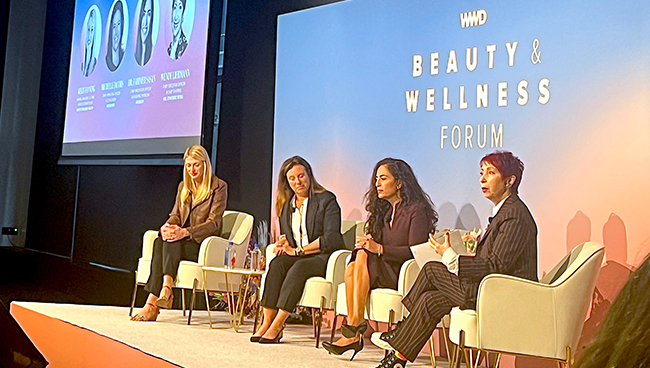By Emily Burns, OCT 06, 2023 || BeautyInc. – A Publication of WWD
A look at how brands including Womaness, Kindbody and Bayer are employing products, campaigns and community to destigmatize women’s health.
At the Beauty & Wellness Forum, Wendy Liebmann, chief executive officer and chief shopper at WSL Strategic Retail, led a discussion on the future of women’s health. Panelists included Kelly Fanning, general manager, United States pain, cardio and dermatology at Bayer Consumer Health; Michelle Jacobs, chief operating officer and cofounder of menopause solutions brand Womaness, and Dr. Fahimeh Sasan, chief innovation officer and founding physician at fertility clinic and platform Kindbody.
Throughout the conversation, panelists emphasized destigmatizing the conversation around women’s health by providing accessible education, using bold messaging and creating communities. For these brands, this looks like products featuring direct-use cases, period campaigns that feature blood, influencer campaigns, online discussion boards, democratizing access to fertility care and more.
“If we’re going to take a proactive preventative approach, it has to start with young people and at every stage of life, and education becomes a fundamental part of that,” said Sasan. “We can’t educate people if it’s a taboo topic.”
The level of silence placed on women’s health has led to massive amounts of misinformation, the panel agreed.
For example, according to Fanning, a big part of Bayer’s mission has been teaching menstruators that periods should not be extremely painful and that they are able to take medications like Midol to ease symptoms, even before they become severe. The brand has seen this sentiment ring true especially with younger generations.
“What we’re finding in this new health and wellness space, what menstruators are really gravitating towards is, it doesn’t need to be that bad. Why should we ever be in discomfort? That was really good insight behind some of our new work called ‘Reach for Comfort,’ driving menstruators to not have to be at that tipping point to reach for comfort,” Fanning said.
And it’s this kind of honest and approachable message that is resonating with consumers, especially in the women’s health space. It’s the same for Jacobs of Womaness, who also emphasized the importance of educating consumers. She said that consumers are lacking in education when it comes to menopause, and often so are doctors. Sasan agreed, noting that on average, OB-GYNs receive just 30 minutes of menopause training during the course of their studies.
“Every nine out of 10 women we spoke to had no idea what the definition of menopause was,” said Jacobs, of when they were building out Womaness. “They didn’t know what perimenopause was. They didn’t have a doctor that they could speak to about what was going on with their body.”
In an effort to shift this, accessible education drives the brand — for Womaness, this comes through on the website with a “Community” tab where women can chat with each other, and a “Learn” tab with educational material, a quiz to find the right products and a newsletter.
“We’re not just skin care supplements and sexual wellness products,” Jacobs said. “We’re really becoming a place to start your journey. We’re finding that as we educate women, it helps with the taboo.”
Making it easy for consumers to find information has also proven successful with Kindbody, as its expansion strategy is to democratize access to fertility care.
“We’re literally on the street corners,” said Sasan. “We intentionally built our clinics on a retail level where people work and play because it was imperative that we brought the conversation out into the open because one out of six adults experiences fertility issues in the United States.”
As with building out locations on popular street corners, employing bold brand messaging is also essential to stand out.
“They [consumers] want it simple and they want it really bold and clear as to what a product does,” said Fanning. “We do that very bold and openly with our first-time menstruators. They want to hear, see everything about it. For the first time in our marketing campaign we showed blood.”
This also looks like bold and clear products that directly state the use cases, such as Womaness’ Me.No.Pause supplement, $47, which outlines hot flashes, night sweats, memory, focus and calm and sex drive as its targets. According to Jacobs, this type of messaging has been successful at acquiring new customers and driving sales.
“There is this hunger for ‘Tell me what I need and [tell] me how to buy it and tell me how to use these products and tell me why I’m having these symptoms’,” she said. “They wanted to know it was going to help them with their hot flashes. It was going to help them with their vaginal dryness. It was going to help them with their wrinkles on their face. They didn’t want to be described as being older…but when they actually talk about the product, they wanted to know the product was really addressing their symptoms.”
For Bayer, tapping influencers to educate consumers and create a sense of community has been a strong strategy, according to Fanning.
“TikTok is where a lot of health and wellness is happening and we’re using content creators,” she said, noting this is a way to use the voice of the consumer. “They’re creating on their own terms and they’re creating their own little communities.”
With this, Sasan also noted, it is key to tap doctors when working on these new products to ensure they understand how they work and are able to share them with patients.
Visit WWD for the full article.


